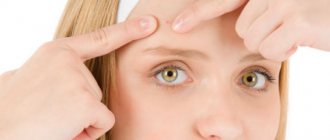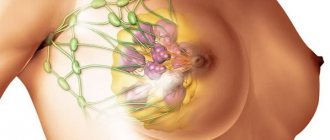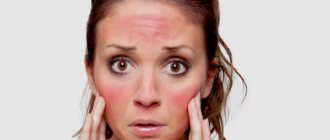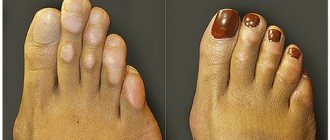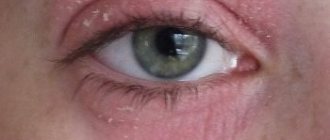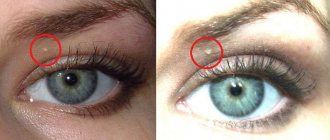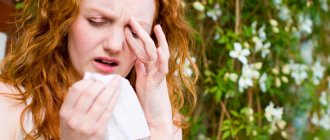Acne on the neck in women: causes
In adulthood, the causes of acne on the neck in women are associated with a number of diseases.
Polycystic ovary syndrome
The disease is characterized by cycle disorders, infertility, sometimes obesity and excessive male pattern hair growth. This is one of the most common endocrine system disorders in women of childbearing age. The analysis shows a decrease in estrogen levels and an increase in testosterone and androstenedione. The egg does not mature and does not leave the follicle. Ultrasound shows enlarged ovaries and formed cysts.
Hyperplasia of the adrenal cortex
The tissues of the organ grow and its functioning is disrupted. The symptoms are vague and require careful diagnosis. In this case, the synthesis of cortisol is disrupted, and despite the fact that this disease is often hereditary in nature in childhood and adolescence, this does not affect the appearance of acne. However, in women at a later age, it causes acne to appear on the face and neck. Along with this, acne is accompanied by a change in the timbre of the voice, an increase in muscle mass, the appearance of male-pattern hair, irregularities in the menstrual cycle or its complete absence, a change in the shape of the labia, and breast reduction.
Acanthosis nigricans
Much less often, dermatologists encounter such a cause of acne as acanthosis nigricans, which manifests itself in the folds of the skin, including the folds between the neck and the back of the head. The skin becomes darker, becomes dry, rough, and a rash appears.
Mechanical injuries and cosmetics
The causes of acne on the neck may be associated with mechanical damage to the skin. Friction and pressure on hair follicles, which are especially numerous in the back of the neck, also provokes inflammatory processes. Rubbing the skin with your palms, using adhesive tape, wearing sweaters and shirts can cause inflammatory elements to appear.
Another reason why acne appears on the neck is the use of cosmetics. Abuse of cosmetics leads to comedones and pustules appearing around the hairs (folliculitis). When neglected, such pustules can turn into large subcutaneous boils - boils. Moreover, closed comedones, papulopustular rashes and open comedones often appear from cosmetics, but rarely. Women try to disguise the rashes with the same cosmetics and thus aggravate the situation. In this case, there is only one treatment - stop using comedogenic cosmetics. These are primarily foundations and contouring preparations, which contain lanolin, isopropyl myristrate, red pigments, etc. Mineral and vegetable oils, which contain most tanning products, enhance their comedogenic properties under the influence of ultraviolet radiation. This partly explains why some women experience acne on their neck and chest during the summer.
Weakened immunity
In people with weakened immune systems and prone to acne, increased acne may be due to long-term treatment with antibiotics and especially tetracyclines. Initially, when tetracycline antibiotics are used to treat acne, they are highly effective, but subsequently they can aggravate the situation by the fact that gram-negative microorganisms begin to predominate in the skin microflora: enterobacteriaceae, proteus, Pseudomonas aeruginosa. Such microorganisms, against the background of weak immunity, lead to the appearance of profuse rashes in the form of papules and pustules. They can be located both on the surface of the dermis and lie deep in it. This disease is called gram-negative folliculitis. The microorganisms that cause acne on the neck of women prefer a moist environment. Therefore, treatment is based on the use of isotretinoin, which has a drying property. The drug has such well-known trade names as Roaccutane and Retinoic ointment. The drug is used for oral administration for severe acne and as a local remedy for various dermatitis and simple acne.
In order for the treatment of acne on the chin and neck to be effective, it is extremely important to know the causes of their appearance and provoking factors. And also strictly observe the dosages and concentrations of medicinal substances, know their combination with other drugs.
“Map of acne” and other problems
Unfortunately, official medicine and modern science are still powerless to create an accurate “picture” of how and where exactly internal problems are reflected on our skin. Doctors continue to study this relationship. But there is no doubt that it exists. For example, persistent and slowly forming age spots on the face often occur with ovarian dysfunction and liver diseases. And an unexpected exacerbation of acne may indicate a disruption of the gastrointestinal tract, liver, pancreas - all this leads to metabolic disorders, which inevitably affects the condition of the skin. In general, if you have long left adolescence and suddenly are faced with the problem of acne, it makes sense to go not to a cosmetologist, but to a clinic and undergo a full examination of the body.
nutritionist, Ph.D. Head of the Rimmarita Medical Center for Aesthetics and Health
Any problem related to the skin is a reflection of problems within the body. Based on the condition of the skin, we can calculate exactly what mistakes we make in nutrition and lifestyle. For example, constipation is often the cause of facial rashes. The condition of the skin on the cheeks and wings of the nose shows how well the small intestine works; on the forehead and temples - the liver and stomach. If there is no clear localization of acne, they appear here and there - pay attention to nutrition and hormonal levels.
Rashes that look like acne
Before you get rid of acne on your neck, you should find out the cause of its appearance. Since some dermatoses look very similar to acne, but have a different nature of origin. Such diseases are called acneiform dermatoses, as they mimic acne. Most often, the causes of dermatoses are associated with medications and food. If acne on the neck is primarily manifested by the appearance of comedones, then dermatoses are characterized by red, cavityless and cavitary purulent elements. Another distinctive feature is that dermatoses quickly and completely disappear, while acne on the neck and face resolves with the formation of scars.
Substances that influence the appearance of acneiform dermatoses:
- taking corticosteroids;
- antidepressants;
- anabolic steroids and B vitamins (doping acne);
- oral contraceptives;
- medicines for the treatment of tuberculosis;
- iodine and bromine preparations taken for several months (vitamins, sleeping pills, sedatives, asthma medications);
- Lugol's solution locally.
Acne on the neck caused by medications is called drug acne. The rash occurs suddenly and disappears quickly after stopping or changing the drug.
Bodybuilder's acne is isolated separately. They appear after taking steroids. These substances help build muscle mass and are very popular among athletes. However, taking anabolic steroids leads to an increase in the secretion of the sebaceous glands and increased seborrhea, including on the neck and cheekbones. Moreover, these can be small pimples, formations with white heads (ulcers) and difficult to treat conglobate and fulminant acne. Women begin to experience changes in their voice, facial hair appears, and the menstrual cycle is disrupted.
Solar acne or acne Mallorca
If in the summer rashes suddenly appear in the form of bandless nodules (papules) on and under the neck, chest, arms, then perhaps these are sun acne, known as Mallorca acne. They appear from the use of oil-based sunscreens, exposure to ultraviolet radiation, and less often from staying in a solarium. Comedones do not appear, but a rash forms in the form of pustules and red dense tubercles. If a person is prone to sun acne, acne may appear annually.
Treatment of acneiform dermatoses
Treatment in this case begins with the elimination of provoking factors, namely the withdrawal of drugs that caused the rash. If cancellation is not possible, therapy begins with the local use of the following agents:
- Azelaic acid;
- Adapalene;
- Isotretinoin;
- Benzoyl Peroxide.
The main emphasis is on local therapy, since the combined use of substances that cause dermatosis and antibiotics can aggravate the situation. If systemic treatment is necessary, preference is given to a drug such as Doxycycline. If therapy is ineffective, isotretinoin is prescribed orally. The dose is calculated individually. On average, the duration of the course is 4-6 months with constant monitoring of blood biochemistry.
Additional methods of therapy are the use of laser, cryomassage, and dermabrasion. With the correct diagnosis, treatment is effective and stable remission is achieved.
Types and their features
Among the most common types of internal acne are:
Each type of subcutaneous acne has a number of characteristics.
Big
Large pimples come in different types.
Among them are:
- papules - large red pimples without pus inside (after pressing they are restored to their size);
- filled with pus (pustules);
- subcutaneous nodes;
- a group of subcutaneous nodes forming a cyst.
Pustules appear as a white head located in the center of the pimple. Squeezing can cause the infection to spread, including blood poisoning. Pustules can develop either independently or transform from papules.
The nodes reach large sizes (more than 3 cm). They are painful, and when squeezed out they leave scars. They are distinguished by their deep location inside the skin, which complicates the process of their treatment.
Several nodes connected by subcutaneous passages form a cyst. Cysts are the most dangerous form of large subcutaneous acne because they are located deep under the skin and are painful. A squeezed cyst almost always leaves a noticeable scar.
Small
Small pimples can appear on the skin either singly or in the form of rashes. They, like large pimples, are papules that do not contain pus. Their appearance is associated with internal problems in the body.
Small pustules contain pus. When pressed, it comes out. Such suppurations often occur due to poor skin hygiene, as well as due to clogging of the sebaceous glands.
Small pimples have a small diameter - no more than 2 mm. At the same time, they are capable of growing to large sizes. Their treatment is most difficult because they remain on the skin for a long time.
Pimples on the neck in women: which organ is wrong?
If acne suddenly breaks out on your neck, you should first identify the presence of hormonal disorders. In women, the adrenal glands and ovaries are responsible for the production of hormones. Often, in patients with acne, polycystic ovary syndrome does not manifest itself with other symptoms such as a change in voice, irregular periods, or decreased sexual desire. Therefore, if acne suddenly appears and there are no results of treatment, you should be examined for the presence of tumors of the ovaries and adrenal glands. To do this, a screening test is performed 2 weeks before the start of menstruation.
FAQ
Ksenia, 26 years old: - Hello, is it true that it is advisable to dilute a mask with clay with peroxide?
Consultation with a specialist: - Good afternoon, Ksenia, yes, you are absolutely right. For a better effect, you can use hydrogen peroxide in masks; add a few drops of it. The result will not be long in coming. The main thing is patience.
Olga, 29 years old: - Tell me, is it necessary to cleanse your face before using masks?
Consultation with a specialist: - Before any procedure, it is advisable to cleanse the face in any available way, for example, wipe the face with lotion or cleanse with a scrub. You can read how to use the scrub correctly here.
What affects the course of acne?
Acne should be treated under the supervision of a doctor and all possible factors that influence the course of the disease should be taken into account:
- Exposure to stress. As such, it does not cause acne, but it significantly aggravates its course.
- Food. According to many dermatologists, food is not the cause of acne (except for drinking whole milk), but a diet that excludes carbohydrates and fats significantly speeds up healing.
- Increased humidity and sweating have a negative impact on the course of the disease.
- Artificial ultraviolet light enhances the formation of comedones and increases sebum production. Many women note that acne appears after tanning.
- Nicotine has a negative effect and slows down recovery.
What can you do at home?
- Washing with tar soap to disinfect and normalize the pH of the skin.
- Applying a compress of St. John's wort, hops, and chamomile flowers to the neck.
- Honey-cinnamon mask (2 tbsp honey, 1 tsp cinnamon) helps relieve inflammation, as well as cleanse and nourish the skin.
- Natural tonic for wiping the face after washing from garlic tincture (2 cloves per 1 liter of water) with the addition of lemon juice (half the fruit).
- Aloe anti-acne lotion. The leaves are ground into porridge (1 glass), poured with water (1 liter) and left for 3 hours. After this, the mixture must be boiled. After cooling, the lotion is ready for use.
- A clay mask once a week cleanses pores and removes excess sebum.
READ ALSO: 6 signs of high cortisol levels in the body
How else to deal with acne at home is described in detail here:
Diagnostics
Acne is a disease that requires an integrated approach. A woman should be examined by a gynecologist, endocrinologist and dermatologist.
The following types of studies are prescribed:
- blood chemistry;
- hormonal profile study;
- skin scraping;
- Ultrasound of the pelvic organs.
Differentiated diagnostics are mandatory to exclude diseases such as rosacea, demodicosis, and gram-negative folliculitis.
What does the “acne map” mean?
Our skin reacts very sensitively to any disruptions in the body. Lack of vitamins and microelements, hormonal changes, disturbances in the functioning of internal organs - all this affects her condition. Even ancient healers discovered a pattern: signs of aging and various skin problems appear primarily in the area of projections of “problematic” internal organs. Sometimes even the skin “signals” before any health complaints arise - for example, the appearance of inflammation or age spots.
Treatment tactics
First of all, treatment of acne in women is carried out taking into account changes in hormonal status, age, presence of diseases and the result of previous therapy (if any).
If small pimples have popped up, with black or white heads and in small quantities, then external treatment will be sufficient. However, if internal acne is diagnosed on the back of the neck or rashes on the lymph nodes, it is necessary to prescribe systemic antibiotics (for oral administration).
Skin care is also important, which acts as a prevention of new rashes. For this area of the body, it is recommended to use salicylic acid and benzoyl peroxide as a cleanser (Baziron AS, Desquam, etc.). For inflammatory elements, Azelaic acid preparations (Skinoren, AcneStop, Azelik, etc.) are also prescribed. They are well tolerated, but may cause irritation and itching in the first week of use. Treatment with Azelaic acid lasts from 1 to 4 months.
In the presence of non-inflamed pimples, therapy is recommended with retinoid drugs (Retin-A, Retinoic ointment, Differin, Clenzit). However, please note that retinoids should only be used at night, as they can cause skin irritation, and they are prohibited during pregnancy and breastfeeding.
If a woman has problems with her hormonal-endocrine status and treatment of acne with external means is ineffective, then hormonal therapy is used. Its goal is to reduce the level of influence of male hormones on the functioning of the sebaceous glands. Oral contraceptives are prescribed first. Their effectiveness is possible even in the absence of a laboratory report on the state of hormonal levels. Hormonal treatment is most effective for acne located in the neck and lower part of the face. Important: treatment is prescribed individually and exclusively by a doctor.
a brief description of
Internal acne is a consequence of the inflammatory process occurring in the ducts of the sebaceous glands.
Inflammation occurs due to the action of provoking factors. As a result, dirt and excess sebum accumulate under the skin, which ultimately causes the appearance of bumps.
Pimples can appear on various parts of the body, but most often affect:
- cheeks;
- forehead;
- chin;
- groin area.
Subcutaneous acne has a dense structure. Their size can reach 2 cm. The formation that appears on the skin first appears in the form of a small red lump, and then grows to a large painful tubercle.
Internal pimples can be either single or multiple. Single formations are not hazardous to health. They can ripen for up to 14 days, after which they disappear on their own. Multiple subcutaneous pimples remain on the face for a long time, giving the skin an unhealthy appearance.


